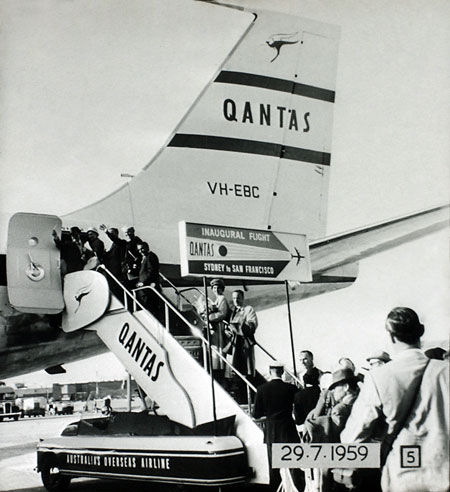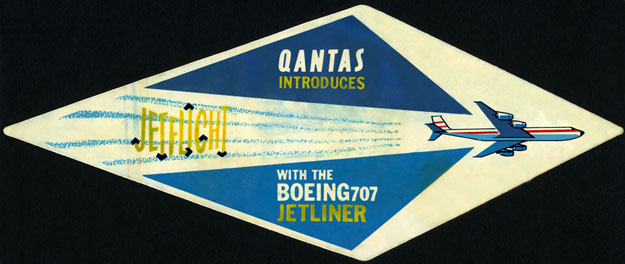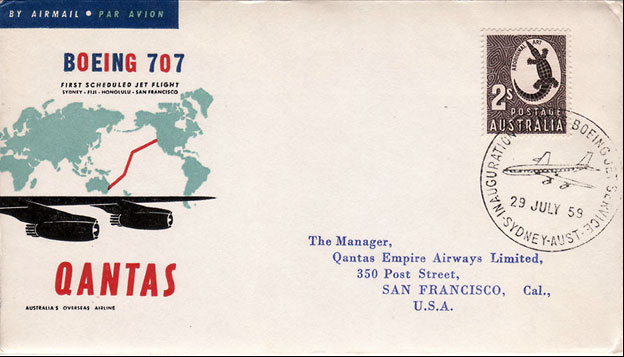
In January 1958, Qantas inaugurated an around-the-world
service using Super
Constellation aircraft. Since the opening of the trans-Pacific Southern
Cross Route in 1954, the route to the USA had become commercially
important to Qantas. Equally, the alternative route to Europe via America was seen as strategically important to Australia, passing as it
did through much more stable parts of the world.
In looking to the future, by the mid 1950s Qantas was considering a range of options to replace the Super Constellations with a new generation of turboprop or jet aircraft offering greater performance. These included the De Havilland Comet 4, Bristol Britannia and Douglas DC-8. In the event, Qantas settled on the Boeing 707 and placed an order for seven in September 1956.

The model chosen by Qantas was the Boeing 707-138. The most demanding route segment on the Qantas network was the long Nadi (Fiji)-Honolulu (USA) sector. The problem was compounded by the relatively short 7,000 ft runway at Nadi and the prevailing high temperatures. In order to provide sufficient performance, Boeing took ten feet out of the cabin length of the -138 in order to reduce weight. The Qantas aircraft were also fitted with a version of the Pratt and Whitney JT3C-6 that allowed the use of additional take-off thrust at Nadi only. Even so, the performance of these early aircraft was often marginal.
As things turned out, thanks to earlier delivery slots US airline Pan American was ready to commence jet services to Australia some six months before Qantas. According to Robert Law-Smith, at the time Qantas Vice-Chairman, he suggested to the Director-General of Civil Aviation, Donald Anderson, that "...perhaps we should make absolutely certain that the runway strength at Sydney would be adequate for Boeing 707 operations and that a departmental study should be undertaken."* The D-G agreed with him and the DCA study took...six months!
The first Qantas passenger jet, VH-EBA, was flown in March 1959 but retained by Boeing for development work and not delivered until 16 July. The second aircraft, VH-EBB, was delivered on 26 June and departed for Australia four days later, setting several speed records en route and creating quite a stir when it arrived in Sydney. Unfortunately it suffered an undercarriage problem whilst training at Avalon on 6 July, but was repaired in time to depart on a proving flight to San Francisco and Vancouver on 21 July.
Thus it fell to the third Qantas Boeing 707, VH-EBB City of Canberra, to operate the inaugural revenue service to San Francisco on 29 July 1959. This marked a considerable step forward in connecting Australia with the world, as trip times were reduced by about 30%. Ultimately, the Boeing 707 would also make possible economical Tourist Class air fares and thus bring international air travel within reach of almost everybody.
(Incidentally, VH-EBA was planned to carry the name City of Canberra, but the name was instead allocated to VH-EBB when this became the first aircraft to arrive in Australia. The name was then transferred to VH-EBC when that aircaft became the one to operate the inaugural service. No doubt this was a Public Relations ploy to keep happy the politicians who, at that time, ultimately controlled Qantas and approved aircraft purchases!)
The technical crew for the inaugural service was: Capt I.D.V. Ralfe, Commander; Capt R.F. Uren, First Officer; Capt C.G. Fox, Second Officer; Navigation Officer R.G. Goodwin; and Engineer Officer K.D. Stark. The photo above, taken from an educational flimstrip about Qantas, shows passengers emplaning on the inaugural service at Sydney/Mascot - note the special sign at the foot of the boarding stairs. The air mail cover below, one of 14,674 items of mail carried on the flight, bears a commemorative postmark applied at the Sydney GPO.
* Quoted in High Corridors: QANTAS 1954-1970 by John Gunn

(Photo:
CAHS collection - Cover & sticker: Phil Vabre collection)
Back to the main Items of General
Interest index
Back to the main Industry Regulation & Aviation Policy index
If this page appears without a menu bar at top and left, click here